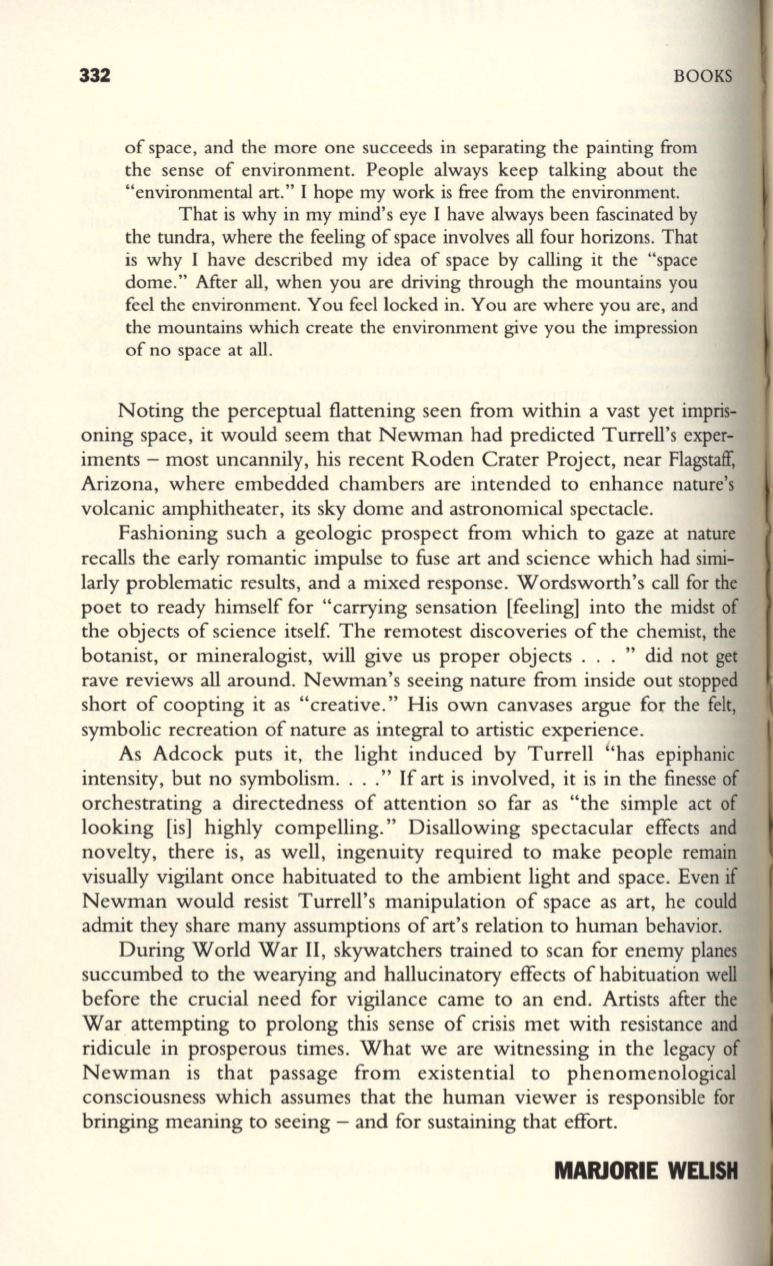
332
BOOKS
of space, and the more one succeeds in separating the painting from
the sense of environment. People always keep talking about the
"environmental art."
I
hope my work is free from the environment.
That is why in my mind's eye I have always been fascinated by
the tundra, where the feeling of space involves all four horizons. That
is why I have described my idea of space by calling it the "space
dome." Mter all, when you are driving through the mountains you
feel the environment. You feel locked in. You are where you are, and
the mountains which create the environment give you the impression
of no space at all.
Noting the perceptual flattening seen from within a vast yet impris–
oning space, it would seem that Newman had predicted Turrell's exper–
iments - most uncannily, his recent Roden Crater Project, near Flagstaff,
Arizona, where embedded chambers are intended to enhance nature's
volcanic amphitheater, its sky dome and astronomical spectacle.
Fashioning such a geologic prospect from which to gaze at nature
recalls the early romantic impulse to fuse art and science which had simi–
larly problematic results, and a mixed response. Wordsworth's call for the
poet to ready himself for "carrying sensation [feeling] into the midst of
the objects of science itself. The remotest discoveries of the chemist, the
botanist, or mineralogist, will give us proper objects .. ... did not get
rave reviews all around. Newman's seeing nature from inside out stopped
short of coopting it as "creative." His own canvases argue for the felt,
symbolic recreation of nature as integral to artistic experience.
As Adcock puts it, the light induced by Turrell "has epiphanic
intensity, but no symbolism.... " If art is involved, it is in the finesse of
orchestrating a directedness of attention so far as "the simple act of
looking [is] highly compelling." Disallowing spectacular effects and
novelty, there is, as well, ingenuity required to make people remain
visually vigilant once habituated to the ambient light and space. Even if
Newman would resist Turrell's manipulation of space as art, he could
admit they share many assumptions of art's relation to human behavior.
During World War II, skywatchers trained to scan for enemy planes
succumbed to the wearying and hallucinatory effects of habituation well
before the crucial need for vigilance came to an end. Artists after the
War attempting to prolong this sense of crisis met with resistance and
ridicule in prosperous times. What we are witnessing in the legacy of
Newman is that passage from existential to phenomenological
consciousness which assumes that the human viewer is responsible for
bringing meaning to seeing - and for sustaining that effort.
MARJORIE WELISH


